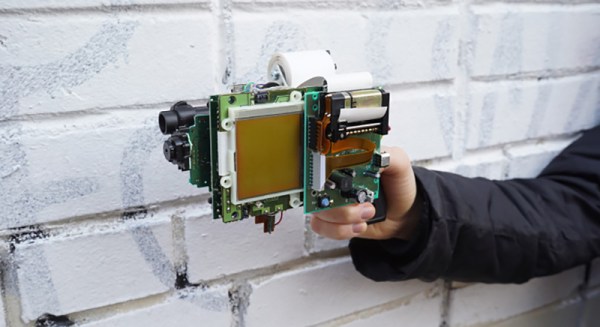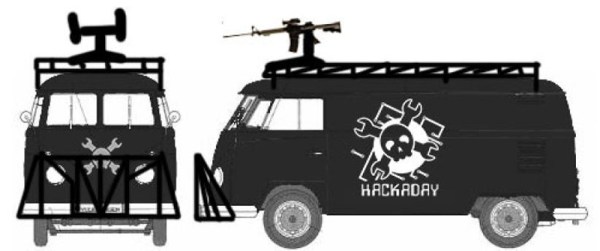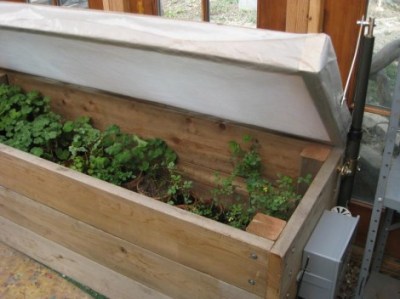Back when [Caleb] was around here at Hackaday, he was tasked with making a few YouTube videos. His Portal Gun got 1.6 Million views, and we got a takedown request because of this video even though that company was more than willing to use [Caleb] as a guinea pig at CES.
This post is not about those videos. This post is about the best project we never did yet.
The grand plan for The Best Project was a zombie survival van. It’s exactly what you think it is: a van armored and armed for driving through a herd of walkers. Proposed mods included a cow catcher and roof rack, a motorized turret, a poofer (propane tanks shooting fire from underneath the van), a bartender that launches molotov cocktails, and a beautiful little contraption called an ankler. The Ankler is just a pair of chainsaws that fold out from under the van.
The base vehicle would be a 60s VW bus. [Caleb]’s a big fan of aircooled stuff, and if you think about it, 60s VWs are pretty good for the zombie apocalypse. If you’re doubting that, just ask how many tools it would take to change out the engine in your car.
Although the dream of a Hackaday aircooled zombie apocalypse van died when [Caleb] left, that doesn’t mean we’re still not considering an official Hackaday ride. All of this is still in the planning stages, but we have a few ideas; the first, and biggest, is a mobile hackerspace on a trailer. This would be a standard semitrailer, loaded up with tools, 3D printers, a laser cutters, and a couch. It would be the perfect thing to load up with swag and haul to events.
We’re considering another more sensible vehicle, and right now the top contender is an early 2000s Astro or Safari cargo van. Yes, I know what you’re thinking: the coolest vehicle we could come up with is a minivan. There’s actually some logic to this, so hear me out.
The Astro/Safari shares a lot of parts with the S10, and that means parts are everywhere. The Astro has an AWD variant, and with a 4″ lift, upgraded suspension and big, knobby tires the Hackaday van would be very, very fun to take out into the desert. It can haul eight foot sheets of plywood, they’re cheap, everywhere, and they just don’t die.
While the best idea right now is an Astro van, we’re also considering other AWD vehicles: an AMC Eagle would be cool, and I think RedBull has a few Suzuki X-90s sitting around. An M35 Deuce And A Half would be fun. A US Mail Truck would probably last forever, and if we go with the semi-trailer concept we would probably want a smaller vehicle on site wherever we park the truck. Current options for this parasitic vehicle include a Nash Metropolitan, a Trabant, a Citroen 2CV, a Renault Dauphine, a Lada, or a Yugo. Yes, they’re all ridiculous but they’re small and can fit in the back of a semi trailer.
It’s still an idea we’re throwing around, but we really need a reason to have a van before we go out and build a hackaspace on wheels, a zombie survival van, or something to launch off some sweet ramps. We don’t go to that many events, and driving a crappy old van across the country a few times a year sounds like fun but surely isn’t.
You can check out [Caleb]’s pitch video for the zombie survival van below.
Continue reading “The Best Project We Never Did Yet” →








 We see it all the time around here, people are building projects to monitor and control their own gardening projects.
We see it all the time around here, people are building projects to monitor and control their own gardening projects.  Perhaps robots are an answer to a different problem.
Perhaps robots are an answer to a different problem.  Stepping back onto the side-track of changes to industrial farming, let’s take a look at one of the way-out-there-ideas from last year. A huge amount of water usage is in food production. What if we turned entire farms into greenhouses in order to capture and reuse water that is normally lost into an all-to-dry atmosphere?
Stepping back onto the side-track of changes to industrial farming, let’s take a look at one of the way-out-there-ideas from last year. A huge amount of water usage is in food production. What if we turned entire farms into greenhouses in order to capture and reuse water that is normally lost into an all-to-dry atmosphere? 













